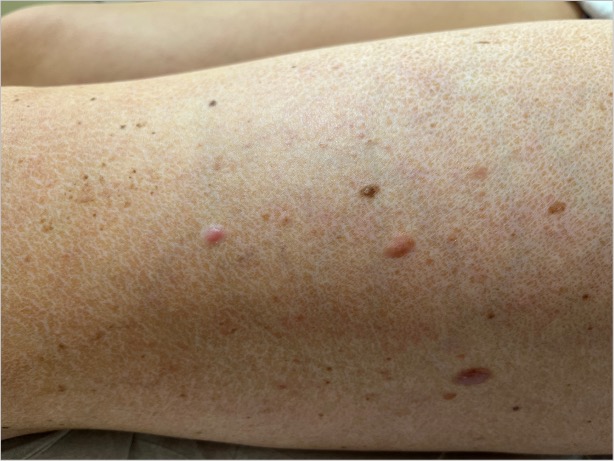Dr. Emily Chu presented information about familial melanoma, inherited melanoma syndromes, and associated genes. Familial melanoma is defined as ≥2 first-degree relatives with melanoma or ≥3 relatives on the same side of the family with melanoma.
First, Chu described genes associated with increased risk of developing melanoma, including cyclin-dependent kinase inhibitor 2A (CDKN2A), cyclin-dependent kinase 4 (CDK4), breast cancer gene 2 (BRCA2), breast cancer gene 1 associated protein-1 (BAP-1), microphthalmia-associated transcription factor (MITF), and protection of telomeres 1 (POT1). CDKN2A mutations or pathogenic variants occur in 10% of families with 2 cases of melanoma and 30-40% of families with ≥3 cases of melanoma. Tumors associated with CDKN2A pathogenic variants include melanoma, pancreatic cancer, breast cancer, lung cancer, gall bladder cancer, neurofibroma, schwannoma, glioblastoma multiforme, malignant peripheral nerve sheath tumor, esophageal squamous cell carcinoma, and papillary thyroid cancer. CDK4 pathogenic variants are often mentioned together with CDKN2A pathogenic variants, but CDK4 is a rare cause of familial melanoma.
BRCA2 is associated with breast and ovarian cancer. Some studies suggest that BRCA2 carriers are 2.5 times more likely to develop melanoma. Patients with documented BRCA2 variants may be referred to a dermatologist for more frequent screening.
BAP-1 tumor syndrome increases the risk for tumors including uveal melanoma, mesothelioma, cutaneous melanoma, renal cell carcinoma (RCC), basal cell carcinoma, onychopapilloma, and BAP1-inactivated melanocytoma. Chu described the clinical and histopathological features of BAP1-inactivated melanocytomas, indolent melanocytic lesions characterized by BAP1 expression loss.
MITF pathogenic variants are associated with familial melanoma and RCC. MITF mutation carriers are more likely to develop dysplastic nevi and multiple primary and nodular melanomas than are non-carriers. MITF pathogenic variants confer moderate risk for melanoma.
POT1 variants are associated with increased risk of melanoma, angiosarcoma, soft tissue sarcoma, and chronic lymphocytic leukemia. Patients with POT1 variants may develop multiple atypical-looking nevi. Telomere dysregulation may be a key process associated with melanoma susceptibility.

Second, Chu discussed considerations for genetic testing. National Comprehensive Cancer Network guidelines for CDKN2A include individuals with 3 primary melanomas or a mix of invasive melanoma, pancreatic cancer, and/or astrocytoma diagnoses in an individual or family on one side. The CM-Score scoring system to predict CDKN2A mutations in melanoma-prone families can guide decision-making. The American Academy of Dermatology guidelines for patients suggest considering germline testing in cutaneous melanoma patients with a family history of ≥3 family members affected on one side or individual history of ≥3 primary invasive melanomas, including one early onset melanoma diagnosed prior to 45 years of age. Other considerations which may affect the threshold for testing include the extent of UV exposure, age of diagnosis, ethnicity, and skin type. In practice, Chu recommends germline genetic testing only for patients who are most likely to benefit from a positive result.
To conclude, Chu shared recommendations for managing patients with inherited melanoma syndromes, including total body skin examination every 6 to 12 months and total body photography. Additional screening may be needed for other relevant cancers depending on the genetic variant.
Mark January 28-31, 2026 on your calendar for the 2026 Annual DF Clinical Symposium.

